| | I | | | | | |  The
town is situated in the Rožňava Fold in the valley of the Slaná River,
under the southern foothills of the Volovské Mountains. Rožňava emerged
as a miners' settlement with golden, silver, and copper mines. The
first written mention of the town dates back to 1291. The first
municipal rights were granted in 1340, the town became a tributary town
in 1382, and it gained full recognition as a free royal town in 1410.
Turkish raids in the 16th century contributed to the decline of mining.
Today, Rožňava is a pleasant town with excellent opportunities for
nature and history lovers. The
town is situated in the Rožňava Fold in the valley of the Slaná River,
under the southern foothills of the Volovské Mountains. Rožňava emerged
as a miners' settlement with golden, silver, and copper mines. The
first written mention of the town dates back to 1291. The first
municipal rights were granted in 1340, the town became a tributary town
in 1382, and it gained full recognition as a free royal town in 1410.
Turkish raids in the 16th century contributed to the decline of mining.
Today, Rožňava is a pleasant town with excellent opportunities for
nature and history lovers. | | |
 | | | 
 |
KLIK
FOTO
= INFO+
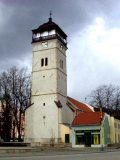
| 
 | | Towns' Watchtower
situated in the middle of the Banikov Square (Miners' S.) was a
part of the original gothic town hall. Construction works began in 1643
during the reign of the mayor Martin Weiszer in order to strengthen
town's defence against the Turkish threat. Because the construction
works were delayed, in 1654 the then-mayor Matej Bako invited Juraj
Gerscheuer, a constructor from the Spis region, who with the assistance
from the local master Daniel Mosszen finished the watchtower in the
same year. A renaissance memorial plaque situated on the southern wall
of the tower honors the two mayors and contains construction dates and
towns' Coat of Arms. Ján Althuem Missnico wrote a detailed history of
the town over the 11 years of the construction of the watchtower and
this document was placed in the attic of the Watchtower. As a reminder
of Turkish raids, above the plaque one can see a stone Turkish
cannonball. On the eight floor of the 38 meters high tower was a room
for guards who controlled town's surroundings from the gallery around
the tower. In 1766 the Watchtower burnt and received a new baroque
roof. ........... | | | 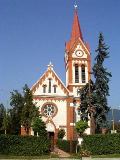 | | Church /evangelical
reformed/, built in 1904 - 1905, brick-made edifice in the Secession
style. /architect: Ferencz Weininger from Budapest, constructor: Ing.
Nándor Szilvássy from Rožňava/. Pulpit with a canopy, benches, and
galleries made of browned wood with golden ornaments come from the
workshop of the local carpentry master Ferencz Boyer (1905). The organ
was mastered by Mr. Š. Kerékgyártó from Debrecín and the ritual table
was made by the carpenter Š. Füleky. There are wooden galleries on cast
columns with decorative chapiters on the east side of the main nave and
in the north nave. ............ | | | 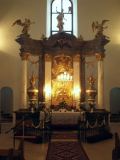 | | Evangelical Church
/evangelical A.c./, built by constructor Mayer in1786 in a closed yard
without a belfry, bells, and direct access from the street, according
to the regulation of that time. It is one of the most beautiful hall
churches built according to those regulations. The altar (woodcarver
Jozef Gode), pulpit, and font with noteworthy spiral-cut marble column
are made in the Luisian style. Organ from 1785 was made by master Ján
Gertner and is one of the most precious works of its kind in the Gemer
region. The church is one of the most important Clasicist buildings in
Slovakia and its construction is linked to the visit of the Emperor
Jozef II in Rožňava in 1783. ........... | | | 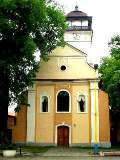 | | Church of St. Frantisek Xav.
- seminar church - /catholic./, baroque edifice, built in 1658 - 1687
on the site of former townhall and protestant school in the middle of
the central square, adjacent to the Watchtower. Construction works
began by Jesuits in 1658. The portal of the church is adorned by two
very precious limewood carvings placed in tabernacles: scultures
depicting King David and Moses. The main altar is from the beginning of
the 20th Century. Lateral altar of St. Alois Gonzaga is of baroque
style from the18th Century. There is a cellar beneath the nave,
probably a relic of the perished townhall, later used as a tomb for
dignitaries of the Remonstrate Order of Roznava. Today the church is
used by the Salesian community. ........ | | | 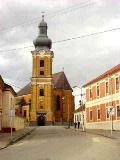 | | Gothic Church of Ascension of St. Mary
/catholic/ built in 13th Century, finished around 1304, first as a
vicar church, since 1776 episcopal church. The tower was built in 1778
- 1779 under the lead of local constructor J. Mayer. The main
late-baroque altar was made by J. Gode in 1779. Lateral altar of St.
Andrew is classicist from 1828. The pulpit is baroque-classicist also
made by J. Gode in about 1770. Marmar classicist font is from 1828. The
most precious object of art of Rožňava is the anonymous late-gothic
board painting "St. Anna" from 1513 that depicts Our Lady with her
mother, St. Anna, and her son Jesus. The painting depicts relaistic
scenes from medieval life of miners and steel workers. ....... | | | 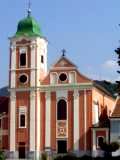 | | Church of St. Anna
/catholic/ and the building of former Franciscan monastery built in
late-baroque style, later received a classicist remake, established on
June 30, 1745. The monastery burnt in 1748. The construction of the
church finished on November 5, 1826. It burned several times and was
repaired in 1906. In that period a small neo-rococo chapel of
Holy Grave was appended to the eastern side of the church. Interior of
the church is adorned by wall paintings of renowned local painter
Július Ádám painted between 1897 and 1918. The main altar is from 1905
made by F. Boger and J. Adám, the organ comes from the Hungarian city
of Salgótarján, statues and altar accesories are from Tyrol, baroque
pulpit is from the 17th century from Kosice, three bells were cast in
Budapest by Frantisek Valtzer in 1892. In the upper half of the facade
is a stucco God's eye with beams. .......... | | | 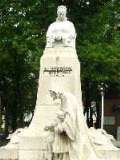 | | Marmar Memorial of Frantiska Andrássyova /maiden name: Hablavcova/
by J. Horvay and E.Samovolsky from 1905. Was ordered by Roznava
municipal council that organized a tender on September 15, 1903 to
built a memorial of this memorable lady who geneorusly supported
schools, humanitarian organizations, nurseries, hospitals, founder of
institutions for blind and deaf-mute people. The memorial was financed
from public donations. Frantiska was a daughter of the director of
Vienna Conservatory and since 1866 the wife of Count Dionyz Andrassy,
with whom she lived in harmony 36 years. She died on October 26, 1902.
The memorial contains a statue of an oldman-beggar and two children,
symbolizing the main beneficiaries of her generosity. ....... | | | 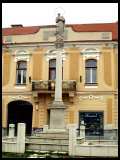 | | Plague Column
in front of the Bischop's Palace, former Jesuit monastery. Built in
1711 in baroque style after the plague epidemic, which within two
months took 2035 lives in the yar 1710. The Column contains the
life-size statue of Our Lady Immaculata. Our Lady stands in a flyaway
robe with hands in a prayer on a symbolic Earth crushing the head of a
snake that winds around the Earth, symbolizing the plague. In 1730 the
statues of St. Florian and Sv. Jan Nepomuk, the patron of the Diocese
of Roznava, were added to the sides of the memorial placed on lower
rectangular columns. ........ | | | 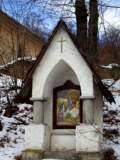 | | Calvary
above the town is a baroque building with several later additions. The
first building with seven chapels were built in 1741 on the initiative
of local burgher Jakub Steer and his wife Katarina and supported by
Ferencz Szabo, the Master of the Jesuit Order in the town. In 1841 the
Calvary was refurbished, a new painting was placed on the main
altar, and six chapels were renovated (one perished in the meantime).
Original paintingsin the chapels, largely damaged, were removed and
replaced by basreliefs ordered in Munich by Bischop Kollarcik. The
chapel of Holy Grave was reconstructed in 1854 by vicar Elek Gromer.......... | | |
down
retep.sk (c) 2002 - 2011
| | | |
|